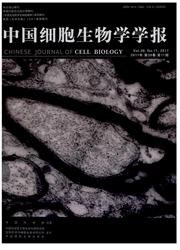

 中文摘要:
中文摘要:
分化的胚软骨表达蛋白1(differentiated embryo-chondrocyte expressed gene 1,DEC1)作为一种时钟蛋白,除了在周期节律的调控中发挥转录抑制作用外,还在能量代谢以及多种肿瘤相关的信号通路的调控中发挥重要作用。此外,蛋白质的翻译后修饰是实现蛋白质功能精细调控的一种重要方式。目前发现,DEC1主要可被两种翻译后修饰,即泛素化和SUMO化修饰。尽管泛素化和SUMO化是两种过程非常类似的蛋白质翻译后修饰方式,但是它们对目的蛋白功能的调控却截然不同。由于泛素化和SUMO化与底物的作用靶点都是赖氨酸(Lys),因此在多数情况下,泛素化和SUMO化以拮抗性的方式调控底物蛋白的功能。鉴于此,该文旨在阐述泛素化和SUMO化修饰对DEC1功能的拮抗调节过程,为了解时钟蛋白DEC1对多种信号通路的调控过程中的分子机制提供新的思路。
 英文摘要:
英文摘要:
DEC 1 (differentiated embryo-chondrocyte expressed gene 1) is a clock protein which plays negative roles in regulation of circadian rhythm. Besides, DEC1 also takes important effect in metabolism and multi-tumor related signaling pathway. Moreover, post-translational modification is also an important regulation way to achieve the meticulous regulation of the protein functions. Recently, DEC 1 could mainly be modified by two post-translational modifications-ubiquitination and SUMOylaiton. Although the processes of ubiquitination and SUMOylati0n are very similar, it is distinct in regulating the function of substrate proteins. Since the substrate target of both ubiquitination and SUMOylation is Lysine (Lys), it is usually ubiquitination and SUMOylation that antagonistly regulate the functions of substrate protein. Therefore, this article aims to describe the antagonism regulation of ubiquitination and SUMOylation for DEC 1, which gives new insights into the molecular mechanism of clock protein DEC 1 in regulating multi-signaling pathway.
 同期刊论文项目
同期刊论文项目
 同项目期刊论文
同项目期刊论文
 PTEN suppresses the oncogenic function of AIB1 through decreasing its protein stability via mechanis
PTEN suppresses the oncogenic function of AIB1 through decreasing its protein stability via mechanis FOXK2 Transcription Factor Suppresses ER alpha-positive Breast Cancer Cell Growth Through Down-Regul
FOXK2 Transcription Factor Suppresses ER alpha-positive Breast Cancer Cell Growth Through Down-Regul EGF is required for cardiac differentiation of P19CL6 cells through interaction with GATA-4 in a tim
EGF is required for cardiac differentiation of P19CL6 cells through interaction with GATA-4 in a tim Induction of the CLOCK gene by E2-ERalpha signaling promotes the proliferation of breast cancer cell
Induction of the CLOCK gene by E2-ERalpha signaling promotes the proliferation of breast cancer cell DEC1 regulates breast cancer cell proliferation by stabilizing cyclin E protein and delays the progr
DEC1 regulates breast cancer cell proliferation by stabilizing cyclin E protein and delays the progr Switching of the Triplet Excited State of Rhodamine/Naphthaleneimide Dyads: An Experimental and Theo
Switching of the Triplet Excited State of Rhodamine/Naphthaleneimide Dyads: An Experimental and Theo The relationship between the inflammatory response and cell adhesion on alginate-chitosan-alginate m
The relationship between the inflammatory response and cell adhesion on alginate-chitosan-alginate m Contributory role of five common polymorphisms of RAGE and APE1 genes in lung cancer among Han Chine
Contributory role of five common polymorphisms of RAGE and APE1 genes in lung cancer among Han Chine DACH1 inhibits SNAI1-mediated epithelial-mesenchymal transition and represses breast carcinoma metas
DACH1 inhibits SNAI1-mediated epithelial-mesenchymal transition and represses breast carcinoma metas 期刊信息
期刊信息
